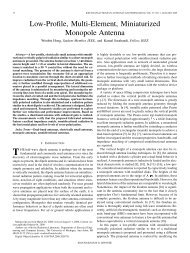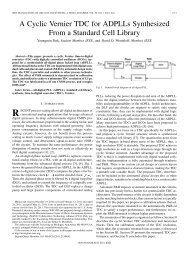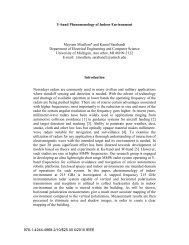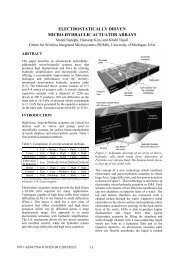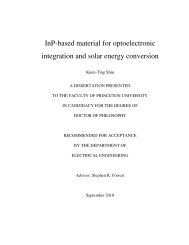A 14 mW Fractional-N PLL Modulator With a Digital ... - IEEE Xplore
A 14 mW Fractional-N PLL Modulator With a Digital ... - IEEE Xplore
A 14 mW Fractional-N PLL Modulator With a Digital ... - IEEE Xplore
Create successful ePaper yourself
Turn your PDF publications into a flip-book with our unique Google optimized e-Paper software.
FERRISS AND FLYNN: A <strong>14</strong> <strong>mW</strong> FRACTIONAL-N <strong>PLL</strong> MODULATOR WITH A DIGITAL PHASE DETECTOR AND FREQUENCY SWITCHING SCHEME 2471<br />
[8] R. Staszewski, J. Wallberg, C. M. Hung, G. Feygin, M. Entezari, and<br />
D. Leipold, “LMS-based calibration of an RF digitally controlled oscillator<br />
for mobile phones,” <strong>IEEE</strong> Trans. Circuits Syst. II, vol. 53, no.<br />
3, pp. 225–229, Mar. 2006.<br />
[9] M. Ferriss and M. P. Flynn, “A <strong>14</strong> <strong>mW</strong> fractional-N <strong>PLL</strong> modulator<br />
with an enhanced digital phase detector and frequency switching<br />
scheme,” in <strong>IEEE</strong> ISSCC Dig. Tech. Papers, 2007, pp. 353–353.<br />
[10] R. C. Walker, “Designing bang-bang <strong>PLL</strong>s for clock and data recovery<br />
in serial data transmission systems,” in Phase-Locking in High-Performance<br />
Systems. Piscataway, NJ: <strong>IEEE</strong> Press, 2003.<br />
[11] R. Staszewski, S. Vemulapalli, P. Vallur, J. Wallberg, and P. T. Balsara,<br />
“1.3 V 20 ps time-to-digital converter for frequency synthesis in 90-nm<br />
CMOS,” <strong>IEEE</strong> Trans. Circuits Syst. II, vol. 53, no. 3, pp. 220–224, Mar.<br />
2006.<br />
[12] M. H. Perrott and M. D. Trott, “A modeling approach for 6-1 fractional-N<br />
frequency synthesizers allowing straightforward noise analysis,”<br />
<strong>IEEE</strong> J. Solid-State Circuits, vol. 37, no. 8, pp. 1028–1038, Aug.<br />
2002.<br />
[13] R. Beards and M. Copeland, “An oversampling delta-sigma frequency<br />
discriminator,” <strong>IEEE</strong> Trans. Circuits Syst. II, vol. 41, no. 1, pp. 26–32,<br />
Jan. 1994.<br />
[<strong>14</strong>] W. Bax, T. Riley, C. Plett, and M. Copeland, “A 61 frequency discriminator<br />
based synthesizer,” in Proc. Int. Symp. Circuits and Systems<br />
(ISCAS), 1995, pp. 1–4.<br />
[15] W. Bax and M. Copeland, “A GMSK modulator using 61 frequency<br />
discriminator-based synthesizer,” <strong>IEEE</strong> J. Solid-State Circuits, vol. 36,<br />
no. 8, pp. 1218–1227, Aug. 2001.<br />
[16] T. H. Lee and J. F. Bulzacchelli, “A 155-MHz clock recovery delayand<br />
phase-locked loop,” <strong>IEEE</strong> J. Solid-State Circuits, vol. 27, no. 12,<br />
pp. 1736–1746, Dec. 1992.<br />
[17] C. M. Hung, R. B. Staszewski, N. Barton, M. C. Lee, and D. Leipold,<br />
“A digitally controlled oscillator system for SAW-less transmitters<br />
in cellular handsets,” <strong>IEEE</strong> J. Solid-State Circuits, vol. 41, no. 5, pp.<br />
1160–1170, May 2006.<br />
[18] C. S. Vaucher, I. Ferencic, M. Locher, S. Sedvallson, U. Voegeli, and Z.<br />
Wang, “A family of low-power truly modular programmable dividers<br />
in standard 0.35-m CMOS technology,” <strong>IEEE</strong> J. Solid-State Circuits,<br />
vol. 35, no. 7, pp. 1039–1045, Jul. 2000.<br />
[19] M. H. Perrott, CppSim Behavioral Simulator Package. [Online]. Available:<br />
http://www-mtl.mit.edu/researchgroups/perrottgroup/tools.html<br />
Mark A. Ferriss (S’03–M’08) received the B.E. degree<br />
from University College Cork, Ireland, in 1998,<br />
and the M.S.E. and Ph.D. degrees in electrical engineering<br />
from the University of Michigan, Ann Arbor,<br />
in 2005 and 2008, respectively.<br />
From 1998 to 2002, he was with Analog Devices,<br />
Limerick, Ireland, during which time he worked on<br />
a variety of projects including DACs, switches, controllers,<br />
and <strong>PLL</strong>s for fiber-optic communications.<br />
His interests include RF communication circuits<br />
and analog-to-digital interface circuits. He currently<br />
holds a postdoctoral research position at the University of Michigan.<br />
Michael P. Flynn (S’92–M’95–SM’98) was born in<br />
Cork, Ireland. He received the B.E. and M.Eng.Sc.<br />
degrees from the National University of Ireland at<br />
Cork (UCC) in 1988 and 1990, respectively, and the<br />
Ph.D. degree from Carnegie Mellon University, Pittsburgh,<br />
PA, in 1995.<br />
He joined the University of Michigan, Ann Arbor,<br />
in 2001 and is now an Associate Professor. He is<br />
Thrust Leader responsible for Wireless Interfaces<br />
at Michigan’s Wireless Integrated Microsystems<br />
(WIMS) NSF Engineering Research Center. From<br />
1988 to 1991, he was with the National Microelectronics Research Centre,<br />
Cork, Ireland. He joined National Semiconductor in Santa Clara, CA, in<br />
1993, and from 1995 to 1997 he was a Member of Technical Staff at Texas<br />
Instruments, Dallas, TX. From 1997 to 2001, he was Technical Director and<br />
Fellow at Parthus Technologies, Cork, and during the same period he was also<br />
a part-time faculty member at the Department of Microelectronics, National<br />
University of Ireland, Cork. His technical interests are in data conversion,<br />
high-speed serial data links, and RF circuits.<br />
Dr. Flynn was named a Fellow by the Guggenheim Foundation in 2007.<br />
He received the 2005–2006 Outstanding Achievement Award from the Department<br />
of Electrical Engineering and Computer Science at the University<br />
of Michigan, the National Science Foundation Early Career Award in 2004,<br />
and the 1992–1993 <strong>IEEE</strong> Solid-State Circuits Pre-doctoral Fellowship. He<br />
serves as an Associate Editor of the <strong>IEEE</strong> JOURNAL OF SOLID STATE CIRCUITS<br />
and on the Technical Program Committees of the International Solid State<br />
Circuits Conference (ISSCC) and the Asia Solid State Circuits Conference<br />
(A-SSCC). He was Associate Editor of the <strong>IEEE</strong> TRANSACTIONS ON CIRCUITS<br />
AND SYSTEMS II from 2002 to 2004. He is a Senior Member of the <strong>IEEE</strong> and a<br />
member of Sigma Xi.



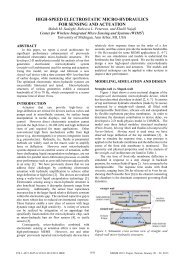
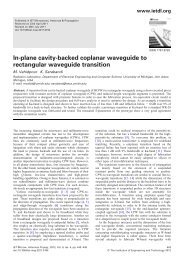
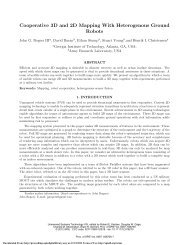
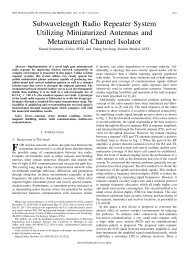
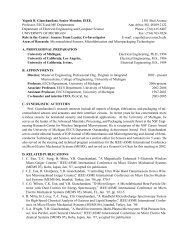
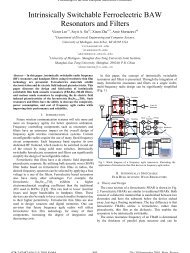
![[Sample B: Approval/Signature Sheet]](https://img.yumpu.com/34084789/1/190x245/sample-b-approval-signature-sheet.jpg?quality=85)

